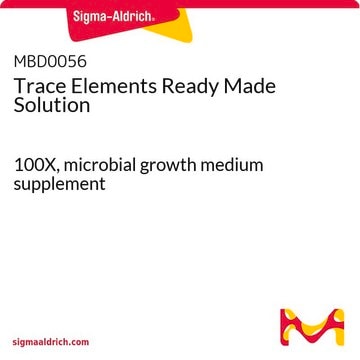MBD0055
MediaBoost
non-animal sterile microbial growth supplement
Synonym(e):
growth supplement for germination, microbial culture additive, microbial culture enhancer, microbial media supplement, minimal growth media supplement
About This Item
Empfohlene Produkte
Qualitätsniveau
Sterilität
sterile
Form
liquid
Methode(n)
microbiological culture: suitable
Versandbedingung
wet ice
Lagertemp.
2-8°C
Eignung
Bacillus spp.
Escherichia spp.
Lactobacillus spp.
Lactococcus spp.
Pseudomonas spp.
Saccharomyces spp.
bacteria
yeasts
Allgemeine Beschreibung
- Chemically defined minimal growth media are often used to grow bacteria for proteomics, as a base for stable isotope enrichment in NMR protein structure-function studies, but growth can be limited without the addition of an effective supplement.
- Use of chemically defined minimal growth media in the production of secreted microbial proteins to ensure reproducibility and a higher concentration of the microbial-produced protein of interest.
Anwendung
- Bacillus subtilis spores in LB medium
- Lactobacillus rhamnosus in LB medium
- Pseudomonas aeruginosa in M9 medium
- Saccharomyces cerevisiae in YPD, BM2, and IMDM media
Please note strains and media combinations and should be tested on a case-by-case basis by the researcher for experiment optimization.
Leistungsmerkmale und Vorteile
- Boosts Growth of Certain Microorganisms
- Reduces Germination Time
- Ready-Made, Sterile Solution
- Protein-Free
Ähnliches Produkt
Lagerklassenschlüssel
12 - Non Combustible Liquids
WGK
WGK 3
Flammpunkt (°F)
Not applicable
Flammpunkt (°C)
Not applicable
Analysenzertifikate (COA)
Suchen Sie nach Analysenzertifikate (COA), indem Sie die Lot-/Chargennummer des Produkts eingeben. Lot- und Chargennummern sind auf dem Produktetikett hinter den Wörtern ‘Lot’ oder ‘Batch’ (Lot oder Charge) zu finden.
Besitzen Sie dieses Produkt bereits?
In der Dokumentenbibliothek finden Sie die Dokumentation zu den Produkten, die Sie kürzlich erworben haben.
Unser Team von Wissenschaftlern verfügt über Erfahrung in allen Forschungsbereichen einschließlich Life Science, Materialwissenschaften, chemischer Synthese, Chromatographie, Analytik und vielen mehr..
Setzen Sie sich mit dem technischen Dienst in Verbindung.





